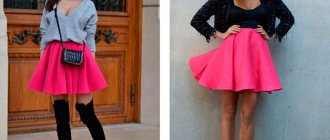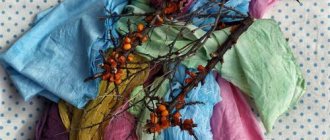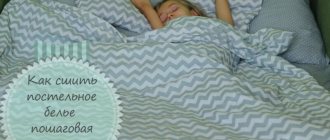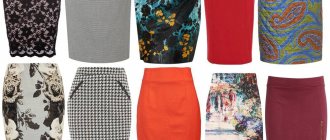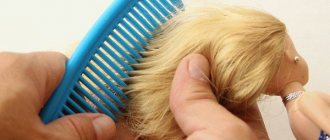In this video I want to show you a simple way to calculate the fabric consumption for sewing any product. I will do this with the help of my irreplaceable assistant, the Valentine program, paper, ruler and scissors.
If you are good at perceiving information in video format, watch the video. If text format is more convenient, read and watch the transcript of this video.
Once you have a drawing of the product, you can calculate how much fabric you need to buy to sew this product. I do this calculation even before printing the pattern in full size.
I will show you the example of a half-sun skirt pattern.
This is how it printed out for me. The outlines of the drawing are faintly visible, so I outline them with a simple pencil or pen.
It became brighter. And now I'm cutting out the details. I placed another blank sheet under this sheet and cut out the skirt detail in two copies at once. Front half detail and back half skirt detail. And I cut out one belt. I already have it in the centerfold. If you cut out half of the belt, then cut it completely.
The parts are cut out and now I will work with them.
I take a ruler and measure the length of the skirt on this miniature pattern. It is equal to 7.5 cm. According to my measurement, Du is equal to 60 cm. In order to find out how many times my miniature skirt length is less than natural, I divide 60 by 7.5 and get the number 8. Number 8 - This is a scale factor. It may be different for you. This value is not constant. Perhaps in mathematics it is called something else, I call it a scale factor. And now, using this coefficient, I find out the miniature width of the fabric, that is, exactly the same on a sheet of paper.
For example, this sheet is a piece of fabric on which I will place my patterns. I need the width of this miniature piece of fabric to match the width of a natural piece of fabric. For example, I looked at a fabric in a store that was 150 centimeters wide, that is, 1 meter, 50 cm. And now I need to understand how wide this miniature piece of fabric should be. To do this, I divide 150 by my coefficient of 8 and get 18.75 cm. I measure this segment from the edge.
And again somewhere in the middle of the sheet. And you can do it again below.
Then I connect all these points with a straight line.
And I cut off this excess “fabric” with scissors. And I am left with a sheet of width corresponding to the width of the fabric 150 cm.
What is the difference between a circle skirt and a circle skirt?
- In appearance, the circle skirt is very fluffy and large. Many girls buy an even larger version, making different folds.
- Both skirts can be varied in length from mini to floor length. For everyday use, most girls vote for the semi-sun model. They fit much nicer into everyday life. The folds falling down are not very deep like the other model. This gives an amazing optical illusion, making every figure look slimmer.
Note! The double sun skirt is often used for gypsy style clothing. A suitable black fabric with red flowers is selected for it.
Model sun
- The sun is made from a whole circle or wedges, and the half-sun is made from half a circle.
- The sun skirt can be made without seams, because it is possible to cut it from a single piece of fabric. The half-sun stitch will be made using one or two stitches.
- For the production of a circle skirt, the amount of fabric required doubles.
- It is advisable to make the half-sun from a material that holds its shape well. And the sun style can be made from a more flowing and light fabric.
- The half-skirt basically has a pocket that is sewn into the seam of the skirt.
- When unfolded, the sun forms a full circle, and a half-sun, respectively, forms a half.
Half-sun style
Tools you will need for work:
- Selected fabric;
- Thin scrapbook paper;
- Measuring tape;
- Ruler;
- Fabric chalk;
- Needles and threads match the color of the item; if you take very contrasting threads, it will ruin the item;
- Scissors;
- Overlock.
Product pattern
Building a basic pattern
The construction of a half-sun skirt pattern begins with creating a right angle on paper.
Next you need to note step by step:
- Waist line (P1);
- Hem line (P2).
How to draw a bottom line
An easy way to create a hem line: take a ribbon or rope and attach a pencil to the end to the length of P2. Secure the beginning of the tape at the head of the corner, and draw a hem line at a distance P2.
An easy way to draw a circle
Half-sun skirt styles
There are various styles of such skirts.
With elastic band
Such models will be a good option for everyday life. It is suitable for any body type. This model is a good choice for overweight girls, it hides some figure flaws.
You may be interested in Sewing a quilted bedspread with your own hands
With belt
Here all the attention is focused on the waist. This choice will look great on a slender figure. This skirt can be easily combined with light flip-flops or sandals.
With smell
It looks quite original and beautiful, because the smell can be both in the front and on the sides. This model can be made in different lengths, so each woman must decide for herself which style will better emphasize the advantages of her figure.
With pockets
The only difference is that there are pockets inside. Basically this is a more daring and daring style of clothing. Therefore, it is preferable to wear it with sneakers and some kind of sweaters or jumpers.
Work process
With these skirt models you can perfectly create a business and work style. Just add a white shirt; it will match any color of the item. As for footwear, it is recommended by all stylists to give preference to sandals or high-heeled shoes. If you wear regular flip-flops, such a skirt will visually shorten your legs. Which for short girls will not be a very pleasant sight. For girls 175+ tall, you can wear not only shoes, but also sneakers with skirts. It looks gentle and bold at the same time. This product is perfect for those with wide hips; large folds will help hide all the imperfections of the figure.
Large fold
As a result, such a skirt is considered one of the universal elements of clothing. It not only hides imperfections, but also emphasizes the perfection of each figure.
General principles
There are general methods for calculating how many meters of fabric are needed for a dress or other product. Such methods are used in mass production of clothing or in ateliers and, according to them, the consumption is taken as standard for a certain style and parameters of the client.
In this technique, everything is simple - measure the length of the intended product and the length of the sleeve, add centimeters to the hem and the resulting number will be the required amount of material.
This method is simple, but does not take into account either the width of the canvas or your parameters. It is suitable only for a figure and height that fits well into a certain clothing size. But for plump or tall girls, as well as those whose top is one size and bottom is another, this technique will not work. They will have to calculate the number of meters more accurately. It is better to use more scrupulous calculations in cases where you are buying expensive fabric for a dress (no one wants to pay for extra centimeters).
To do this, take into account:
- fabric width;
- your volumes and growth;
- style;
- the presence of decorative elements;
- features of the fabric, such as pile or pattern.
Let's take a closer look at calculating the amount of fabric based on these aspects.
Choice of fabric for sewing.
Such a skirt should be soft and light, made of natural or synthetic fabric. The best products will be made from natural silk. But if there is a strong wind when walking outside, then you should discard the skirt, as it will easily lift it to the waist. Based on this, when thinking about what material to choose for a semi-sun skirt, you need to take care of buying a lining. A small mesh made of artificial threads works well.
Summer looks
For the summer, you can make a lining of chiffon or tulle. It will look like a bell if a thin wire is sewn along the edge of the product. The product will be light, the petticoat will keep the layers from sticking to the body. It’s both beautiful in appearance and not stuffy, despite the large amount of fabric.
The success of the finished product will depend on the correct choice of fabric. For the autumn version of the skirt, you can take leather or draped fabric.
But no matter what material was chosen, you only need to work on a sewing machine. So that the stitching is smooth and strong. No matter how skilled the needlewoman is, it is difficult to make a high-quality skirt by hand.
You might be interested in: Creating patterns and sewing school aprons for the last bell
Cotton lace hem decoration
Many girls decorate the hem of their summer skirt with light lace. Which makes her soft and very cute.
For women with an hourglass figure
For ladies with developed hips, a semi-sun skirt will be the ideal choice. Important details:
- It is advisable to choose a fabric for a skirt that drapes well, creating soft ruffles;
- the model should be high-waisted and have a perfectly fitting belt;
- the flare should start from the middle of the thigh;
- The length of the skirt is to the knees and below.
Necessary calculations
To tailor the product correctly, you need to take measurements. They will be different from those when, for example, they are removed when sewing trousers or a dress. You only need two measurements, waist circumference and the length of the skirt you want to make. Therefore, taking measurements is very simple, even a child can do it.
How to draw a line for the bottom of a skirt?
From the points of the waist line, count the required length of the skirt. And mark points 1 and 2. From the main point, use a centimeter to draw a bottom line.
Now you need to adjust both lines. To do this, make the waist line and bottom line not very convex. From point 2, mark up 3 cm and place point 3. Draw a new waist line.
Lush double sun
And from point 2 up, mark 4 cm. Draw a new bottom line through mark 3.
The skirt pattern can be drawn directly on the product; it is important to lay out the fabric correctly at first, taking into account the grain thread.
Calculation for forming the hem line
To draw the hem line correctly, you need to calculate its radius. To do this, you need to add two sums: the length of the skirt and the waist radius. This number will be the hem radius. To reduce the “sagging” of the bottom when constructing a drawing, you need to raise the middle of the arc by 4 cm, and the waist line by 3 cm. If the bottom will be decorated with lace, bias tape, various scraps of fabric, then you need to add another 3 cm.
Attention! If the skirt should have large folds, the size of the radius of the waist and bottom arc will not differ much from the style of the product without folds. To make the calculation correctly, you need to decide how many folds a person wants.
Calculating the radius of a circle for drawing the waist
In order not to spoil the material, you need to accurately carry out all the necessary calculations, and this mainly concerns the calculation of the radius of the waist circumference. This requires a curvature coefficient that is different for each style of bell skirt. For this species it will be 0.65. If you have some difficulties with this, you can use an online calculator to calculate the radius. But more experienced craftsmen are accustomed to counting on their own and trusting themselves more than the machine.
How to calculate the amount of fabric for a double sun skirt
The fabric consumption for a semi-sun skirt depends on the number of pleats desired. Double sun is half the waist circumference divided by 2 pi and the result is (34:6.28) the radius will be 5.4 cm. The method for calculating this style of product. To begin, take half the waist circumference and sew one sun-style panel for the front and back, connect the two parts into one skirt.
You might be interested in this: Summer sundress pattern and sewing yourself
Children's version of the product with elastic band
If you need a floor length, then the width of the fabric will not be enough, so you need to cut out not two, but four parts; in this master class, the material is folded in four layers.
Lay the material on the floor and mark a radius of 5.4 cm from the corner of the product, draw a line.
Next, measure the length of the skirt, in this case it will be 69 cm. Draw rays of this length along the fabric and mark the waist radius). Next, use the finished marks to draw a line for the length of the hem. In the center of the bias cut, the bottom will sag the most, so the line needs to be edited about half a cm towards the waist.
Cut the resulting part in half, these will be the side seams.
Mini skirt
The skirt option can be long or mini. Double sun will look more beautiful if it is just above the knee. Its layers can be opened up and worn, for example, with a top or jumper, creating a 70s style.
Option 2
I arrange the skirt parts so that the middle of the parts runs parallel to the grain of the fabric. And at the same time, the parts are located strictly one below the other. For example, if the fabric has vertical stripes and I want these stripes to be placed equally on both the front and back halves. Then on the side seams I can combine these stripes and it will look like a herringbone. For checkered fabric, you can also choose this arrangement of parts. I measure the distance from the top edge of the miniature piece of fabric to the top edge of the ruler and get 18.5 cm. I multiply 18.5 by 8, I get 148 cm. You can buy 1.5 meters of fabric. And notice that I have space between the pattern pieces for seam allowances. Seam allowances in general can also be calculated using a coefficient. But it will be even easier if you print the details from Valentina with allowances. And then the parts can be moved tightly towards each other.
Required measurements
Attention! Any tailor's work begins with taking measurements.
For this you need a tape centimeter. Measure your waist circumference, hip circumference and desired length. It is advisable to write down the measurements taken. Since you can’t get confused in them even by 1 cm.
Ironing process
These types of skirts need to be washed very carefully. Due to the large number of folds, they should not be pressed at high speeds. You can dry it in any position; ironing is allowed only at a temperature of 40-45 degrees.
In conclusion, it should be noted that making a half-sun skirt is quite simple. It is important to know all the measurements and the formula by which you need to calculate fabric consumption. To understand how much fabric is needed for a semi-sun, you need to look at sample product models on the Internet and choose something for yourself. The only difficulties that may arise are calculating the radius for the skirt. For beginning tailors, it will be difficult to figure out the formula at first. But to do this, you can go to various forums, where they can describe what it is and how to calculate it.
Uncover
I lay the fabric on the table, straighten it, take a measuring tape and start drawing the waist section.
From the corner at the top I mark 30 cm.
Then, using the principle of a compass, I leave the top of the tape in the corner, move the tape itself and put marks.
I raise the waist line diagonally by 1 cm, mark 29 cm. And then again 30.
I connect the marks with one arc.
Then I make the second arc in the same way. In my case, 91 cm. Diagonally I mark 90 cm, 1 higher, the same as at the waist.
I cut along an arc of 91 cm. Then I put the cut side on the opposite corner, align it very carefully, and fix it with needles.
I cut off the second part of the skirt along the first at the bottom and cut off both at the top.
The belt is made up of two parts, each 47 cm long. The elastic band is 3 cm wide, so the width of the belt strips is 8.5 cm.
I cut out the pockets into whatever shape I like. Straight side - pocket entrance - 17 cm.
Instead of an afterword
Regardless of what style of clothing a girl prefers, a half-sun skirt will always have a place in her wardrobe. After all, such a model fits perfectly into the image of a romantic, gentle nature and femme fatale vamp. This can be a warm winter option, or vice versa, a detail of a beach ensemble. You just need to choose the appropriate style that matches your type of activity and age category. Cutting and sewing such a skirt with your own hands will not be difficult even for novice seamstresses who are just beginning to master the basics of this exciting activity. After all, the number of necessary parts for the product is minimal, and the sewing technology is quite simple for beginners.
With pleats
You can sew an interesting skirt by adding pleats at the waist.
To do this, you need to decide how many there will be and what depth you want. Let’s say there are 4 folds in the front and back with a depth of 3 cm. We get the length of the waist circumference equal to (38*2 + 8*3*2) / 3 - 2 = 124 cm.
Calculate the length of the lower arc based on your measurements.
Who is it suitable for?
We can safely say that this model is suitable for all types of female figures. She corrects shortcomings and emphasizes the advantages of the owner. So, for girls with a weakly defined waist it emphasizes it, for girls with a pear-shaped figure it balances the top and bottom, and for a T-figure, on the contrary, it adds volume in the missing places.
A well-chosen style visually added height and reduced the volume of the figure.
Materials
To sew a half-sun skirt for a girl, a girl or a woman, you need a fabric that has high plasticity and holds its shape. For summer options, lighter and thinner materials are suitable. The most commonly used for sewing these products are:
- Tweed. This is a wool material with a textured surface. It is practical, warm, and allows you to achieve clear folds on your skirt. Thanks to its texture, the material gives additional volume, which is especially important for women with very narrow hips. For plump ladies, it is better to avoid such fabric.
- Fatin. Light, smooth material, from which holiday products are often sewn. The volume of the skirt depends on its rigidity. You can combine it with different blouses and tops. Disadvantages of tulle: it is highly electrified and can become deformed when placed near heating devices.
- Denim. This option is used for everyday wear. The fabric is thin and natural, so it will not cause discomfort even in the summer heat. As for the folds, they are made in the form of natural gathers. Denim fades over time and may sag after washing.
- Leather. The material is suitable for those fashionistas who are not afraid to experiment. It is better to use medium or long models. Thanks to the natural shine of the skin, the folds create beautiful shimmers, so the look will be bright, even if the top is dark in color. The disadvantage of the material is its high cost.
- Knitwear. To sew such a skirt, you need fabric with a dense texture. This material often does not have artificial folds. The relative disadvantage is that it looks simple.
- Chiffon. Used for sewing floor-length summer items. This material allows air to pass through well and hides some silhouette imperfections. It is somewhat capricious in care, so you need to handle it with care.
- Chintz. Natural lightweight fabric used for sewing summer skirts. It is pleasant to the touch and can be plain or with a printed pattern. This material allows air to pass through well, but quickly wrinkles, shrinks when washed, and is damaged when exposed to high temperatures.
- Suede leather. This skirt is soft, velvety, silky. Its texture is porous. It is better to use an artificial version, as it practically does not wrinkle and holds its shape well. For tailoring, you can choose any shade.
It is better not to use natural linen for sewing, as it quickly wrinkles and shrinks when washed. Cotton also has the same disadvantages, which, moreover, wears out quickly.
Tweed
Fatin
Denim
Leather
Knitwear
Chiffon
Chintz
Suede

